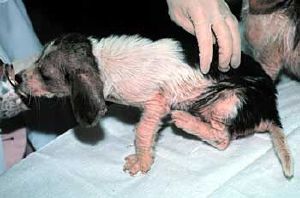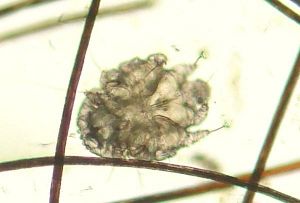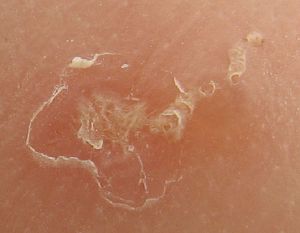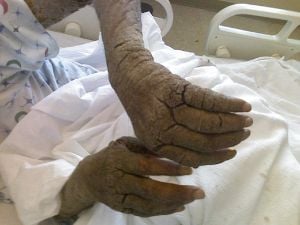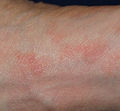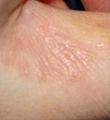Difference between revisions of "Scabies" - New World Encyclopedia
Rick Swarts (talk | contribs) |
Rick Swarts (talk | contribs) |
||
| Line 14: | Line 14: | ||
}} | }} | ||
| − | '''Scabies''' is a transmissible [[Parasitism|ectoparasite]] [[skin]] [[infection]] caused by tiny [[mite]]s of the species ''Sarcoptes scabiei'', with the [[disease]] characterized by intense itching (pruritus), a rash, and [[secondary infection]]. The human scabies mite, ''Sarcoptes scabiei'' var. ''hominis'', is responsible for human infections, | + | '''Scabies''' is a transmissible [[Parasitism|ectoparasite]] [[skin]] [[infection]] caused by tiny [[mite]]s of the species ''Sarcoptes scabiei'', with the [[disease]] characterized by intense itching (pruritus), a rash, and [[secondary infection]]. The human scabies mite, ''Sarcoptes scabiei'' var. ''hominis'', is responsible for human infections, which are characterized by superficial burrows where the mite burrows under the skin. Domestic and wild animals also may be infected by various varieties of ''Sarcoptes'' mites, such as ''S. scabiei var. canis'' that is a parasite of [[dog]]s and [[fox]]es. Varieties affecting domestic animals may be transferred to humans (Chakrabarti 1985; Ulmer et al. 2007; Mumcuoglu and Rufli 1979). This article will be about infection in humans, unless otherwise stated. |
Scabies is most prevalent among people in overcrowded conditions and conditions of poor hygiene (Carson-DeWitt | Scabies is most prevalent among people in overcrowded conditions and conditions of poor hygiene (Carson-DeWitt | ||
| Line 30: | Line 30: | ||
==Overview== | ==Overview== | ||
| − | + | In humans, scabies is [[etiology|caused]] by the tiny [[mite]] ''[[Sarcoptes scabiei]]'', variety ''hominis'', as shown by the Italian biologist [[Diacinto Cestoni]] in the 18th century. The infection produces intense, itchy skin [[rash]]es when the impregnated female tunnels into the [[skin]]'s outermost layer, the [[stratum corneum]], and deposits [[egg (biology)|eggs]] in the burrow. Upon hatching, the [[larva]]e move to the surface of the skin, [[ecdysis|molt]] into a "[[nymph (biology)|nymphal]]" stage, mature into adult mites, and mate, and repeat the life cycle either within the original host or its next host (Carson-DeWitt 2002; Jacques 2008). The action of the mites moving within the skin and on the skin itself produces an intense itch, which may resemble an [[allergic reaction]] in appearance. The presence of the eggs produces a massive allergic response which, in turn, produces more itching. | |
| − | + | Scabies is transmitted readily, often throughout an entire household, by skin-to-skin contact with an infected person (e.g. bed partners, schoolmates, daycare). Spread by clothing, bedding, or towels is a less significant risk, though possible. | |
| − | + | In individuals with strong [[immune systems]] and those that scratch (which apparently, often inadvertently, removes some of the mites), infections commonly involve no more than 15 mites altogether, with an average of 11 adult females in an affected human host (Jacques 2008; Carson-DeWitt 2002). However, in those physically infirm, or otherwise immunocompromised, such as the eldery, there may be an infection with a more severe variant called crusted scabies or Norwegian scabies, with a human host infected by more than 2 million adult females (Jacques 2008; Carson-DeWitt 2002). This type of infection involves thickened, crusty areas all over the body (Carson-DeWitt 2002). | |
[[Image:Scabies puppy.jpg|thumb|left|Puppy with Scabies (Sarcoptic mange)]] | [[Image:Scabies puppy.jpg|thumb|left|Puppy with Scabies (Sarcoptic mange)]] | ||
| − | + | [[Image:Canine scabies mite.JPG|thumb|right|''Sarcoptes scabiei var. canis'' (dog scabies mite)]] | |
| + | Various varieties of ''Sarcoptes scabiei'' may infect wild and domestic animals. ''S. scabiei'' var. ''canis'' is parasitic on dogs, foxes, and wolves, causing sarcoptic mange, and it can also infect [[cat]]s and humans to a lesser extent. ''S. scabiei'' var. ''wombati'' affects wombats. ''S. scabiei'' var. ''cuniculi'' is the rabbit scabies mite. ''S. scabiei'' var. ''bovis'' infects cattle. These mites typically are [[adaptation|adapted]] to their preferred host, but often can transfer to other hosts, including humans. Mumcuoglu and Rufli (1979) report a case where ''S. scabiei'' var. ''bovis'' infected a farmer. They further reported that this variety penetrates the human skin, but does not form burrows, which is in contrast to typical ''S. Scabiei'' infections, such as with variety ''hominis''. | ||
| − | |||
| − | |||
==Sarcoptes scabiei== | ==Sarcoptes scabiei== | ||
Revision as of 15:49, 17 May 2008
| [[Image:|190px|center|]] | |
|---|---|
| ICD-10 | B86 |
| ICD-O: | |
| ICD-9 | 133.0 |
| OMIM | [1] |
| MedlinePlus | [2] |
| eMedicine | derm/382 |
| DiseasesDB | 11841 |
Scabies is a transmissible ectoparasite skin infection caused by tiny mites of the species Sarcoptes scabiei, with the disease characterized by intense itching (pruritus), a rash, and secondary infection. The human scabies mite, Sarcoptes scabiei var. hominis, is responsible for human infections, which are characterized by superficial burrows where the mite burrows under the skin. Domestic and wild animals also may be infected by various varieties of Sarcoptes mites, such as S. scabiei var. canis that is a parasite of dogs and foxes. Varieties affecting domestic animals may be transferred to humans (Chakrabarti 1985; Ulmer et al. 2007; Mumcuoglu and Rufli 1979). This article will be about infection in humans, unless otherwise stated.
Scabies is most prevalent among people in overcrowded conditions and conditions of poor hygiene (Carson-DeWitt
treatment
The word scabies comes from the Latin word for "scratch" (scabere).
Overview
In humans, scabies is caused by the tiny mite Sarcoptes scabiei, variety hominis, as shown by the Italian biologist Diacinto Cestoni in the 18th century. The infection produces intense, itchy skin rashes when the impregnated female tunnels into the skin's outermost layer, the stratum corneum, and deposits eggs in the burrow. Upon hatching, the larvae move to the surface of the skin, molt into a "nymphal" stage, mature into adult mites, and mate, and repeat the life cycle either within the original host or its next host (Carson-DeWitt 2002; Jacques 2008). The action of the mites moving within the skin and on the skin itself produces an intense itch, which may resemble an allergic reaction in appearance. The presence of the eggs produces a massive allergic response which, in turn, produces more itching.
Scabies is transmitted readily, often throughout an entire household, by skin-to-skin contact with an infected person (e.g. bed partners, schoolmates, daycare). Spread by clothing, bedding, or towels is a less significant risk, though possible.
In individuals with strong immune systems and those that scratch (which apparently, often inadvertently, removes some of the mites), infections commonly involve no more than 15 mites altogether, with an average of 11 adult females in an affected human host (Jacques 2008; Carson-DeWitt 2002). However, in those physically infirm, or otherwise immunocompromised, such as the eldery, there may be an infection with a more severe variant called crusted scabies or Norwegian scabies, with a human host infected by more than 2 million adult females (Jacques 2008; Carson-DeWitt 2002). This type of infection involves thickened, crusty areas all over the body (Carson-DeWitt 2002).
Various varieties of Sarcoptes scabiei may infect wild and domestic animals. S. scabiei var. canis is parasitic on dogs, foxes, and wolves, causing sarcoptic mange, and it can also infect cats and humans to a lesser extent. S. scabiei var. wombati affects wombats. S. scabiei var. cuniculi is the rabbit scabies mite. S. scabiei var. bovis infects cattle. These mites typically are adapted to their preferred host, but often can transfer to other hosts, including humans. Mumcuoglu and Rufli (1979) report a case where S. scabiei var. bovis infected a farmer. They further reported that this variety penetrates the human skin, but does not form burrows, which is in contrast to typical S. Scabiei infections, such as with variety hominis.
Sarcoptes scabiei
| Sarcoptes scabiei | ||||||||||||||||||||||||||
|---|---|---|---|---|---|---|---|---|---|---|---|---|---|---|---|---|---|---|---|---|---|---|---|---|---|---|
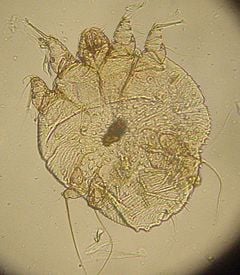 | ||||||||||||||||||||||||||
| Scientific classification | ||||||||||||||||||||||||||
| ||||||||||||||||||||||||||
| Sarcoptes scabiei De Geer, 1778 |
Sarcoptes scabiei is a parasitic arthropod which burrows into human skin and causes scabies.
The Italian biologist Diacinto Cestoni showed in the 18th century that scabies is caused by the mite Sarcoptes scabiei, variety hominis. The disease produces intense, itchy skin rashes when the impregnated female tunnels into the stratum corneum of the skin and deposits eggs in the burrow. The larvae, which hatch in 3–10 days, move about on the skin, moult into a nymphal stage, and then mature into adult mites. The adult mites live 3–4 weeks in the host's skin.
The action of the mites moving within the skin and on the skin itself produces an intense itch which may resemble an allergic reaction in appearance. The presence of the eggs produces a massive allergic response which, in turn, produces more itching.
The sarcoptes are a family of skin parasites, and are a part of the larger family of mites collectively known as “scab mites”; they are also related to the scab mite “psoroptes”, also a mite that infests the skin of domestic animals. Sarcoptic mange affects domestic animals and similar infestations in domestic fowls causes the disease known as “scaly leg”. The effects of the sarcoptes scabiei are the most well known, causing “scabies”, or “the itch”. The adult female mite, having been fertilised, burrows into the skin, usually the hands or wrists, however other parts of the body may also be affected, and lays its eggs.
The burrowing is carried out using the mouthparts and special cutting surfaces on the front legs. While these are being used, the Sarcoptes scabiei anchors itself with suckers on its feet. Eggs are laid in small numbers as the mite burrows, and as these hatch, six-legged larvae climb out on to the skin and search for hair follicles, where they feed and moult (discard old cuticles to grow). It is in the hair follicles that the larvae show the first nymphic stages, with eight legs. In the nymphic stages, the creature feeds and moults and, if male, gives rise to the adult. In the case of females, another moult occurs before adulthood. The female has more moults than a male and therefore takes longer – seventeen days to the other nine to eleven days for a male to reach adulthood. The female is about twice the size of the male.
Although the life cycle is only about two weeks, individual patients are seldom found to have more than about a dozen mites on them. Even so, this number can cause agonising itching, in particular at night, and severe damage to the skin often comes as a result of scratching, particularly by the introduction of infective bacteria, which may lead to impetigo or eczema.
The eggs are laid by the female at a rate of about two to three eggs a day for about two months. It is considered that about two per cent of the British population is infected with these mites, it taking about twenty-five minutes to an hour to burrow into the skin.
The best conditions in which to harbour Sarcoptes scabiei is in areas where there is frequent skin to skin contact, therefore (as also mentioned previously) the hands and wrists, as the mites are transmitted by skin contact with carriers, and they very easily spread. Infestations of Sarcoptes scabiei are commonly found in pigs. They significantly depress growth and feeding rate, but usually die out in around five days from in typical farm conditions. However, once in a herd, the mites are very hard to be ridden of without great measures being taken.
Onset
It takes approximately 4-6 weeks to develop symptoms after initial infestation. Therefore, a person may have been contagious for at least a month before being diagnosed. This means that person might have passed scabies to anyone at that time with whom they had close contact. Someone who sleeps in the same room with a person with scabies has a high possibility of having scabies as well, although they may not show symptoms.
The symptoms are caused by an allergic reaction that the body develops over time to the mites and their by-products under the skin, thus the 4-6 week "incubation" period. There are usually relatively few mites on a normal, healthy person — about 11 females in burrows. Scabies are microscopic although sometimes they are visible as a pinpoint of white. The females burrow into the skin and lay eggs there. Males roam on top of the skin, although they can and do occasionally burrow. Both males and females surface at times, especially at night. They can be washed or scratched off (however scratching should be done with a washcloth to avoid cutting the skin as this can lead to infection), which, although not a cure, helps to keep the total population low. Also, humans create antibodies to the scabies mites which do kill some of them.
Signs, symptoms, and diagnosis
A tiny mite (0.3 to 0.9 mm) may sometimes be seen at the end of a burrow. Most burrows occur in the webs of fingers, flexing surfaces of the wrists, around elbows and armpits, the areolae of the breasts in females and on genitals of males, along the belt line, and on the lower buttocks. The face usually does not become involved in adults.
The rash may become secondarily infected; scratching the rash may break the skin and make secondary infection more likely. In persons with severely reduced immunity, such as those with advanced HIV infection, or people being treated with immunosuppressive drugs like steroids, a widespread rash with thick scaling may result. This variety of scabies is called Norwegian scabies.
Scabies is frequently misdiagnosed as intense pruritus (itching of healthy skin) before papular eruptions form. Upon initial pruritus the burrows appear as small, barely noticeable bumps on the hands and may be slightly shiny and dark in color rather than red. Initially the itching may not exactly correlate to the location of these bumps. As the infestation progresses, these bumps become more red in color.
Generally diagnosis is made by finding burrows, which often may be difficult because they are scarce, because they are obscured by scratch marks, or by secondary dermatitis (unrelated skin irritation). If burrows are not found in the primary areas known to be affected, the entire skin surface of the body should be examined.
The suspicious area can be rubbed with ink from a fountain pen or alternately a topical tetracycline solution which will glow under a special light. The surface is then wiped off with an alcohol pad; if the person is infected with scabies, the characteristic zigzag or S pattern of the burrow across the skin will appear.
When a suspected burrow is found, diagnosis may be confirmed by microscopy of surface scrapings, which are placed on a slide in glycerol, mineral oil or immersion in oil and covered with a coverslip. Avoiding potassium hydroxide is necessary because it may dissolve fecal pellets. Positive diagnosis is made when the mite, ova, or fecal pellets are found.
Compromised immune systems
People with compromised immune systems may not develop antibodies to the mites and may develop crusted Norwegian scabies. In this case, many form scabs or develop very red skin especially in the elderly and the mentally handicapped where white or gray crusted areas develop with little itching and little or no red bumps and mite population numbers rise to thousands in AIDS patients [citation needed]. These cases require additional treatment options to ensure a complete kill. Ivermectin is a single oral treatment of choice in these patients combined with any other topical treatment.
Gallery of scabies infections
Evolution of infection
Treatment
Medications
Topical
- Permethrin[1]: Another pesticide, lacks carcinogenic and teratogenic testing in humans although animal tests showed no signs of carcinogenic or teratogenic effects. Toxicity may resemble allergic reactions.[2]
- Eurax (USP Crotamiton)[3]
- Malathion Applied for 24 hours effective in killing adults and eggs.
- Lindane (Kwellada): For use with patients where permethrin has failed or is contraindicated.[4]
- Lindane is FDA approved as safe and effective when used as directed for the second-line treatment for both scabies and lice. Serious side effects are rare and have almost always resulted from product misuse.[5][6] Lindane is registered for use in 50 countries, with restricted-use status in 33 of these countries.[6][7] The latter includes the U.S. and Canada, which support public health uses of pharmaceutical lindane but no longer allow agricultural applications.[6][8] Lindane should be washed off with warm, and not hot, water to avoid absorption through the skin.[9] Five to –10% sulfur ointments are considered historical.
- 10% sulfur ointment: Can be used in pregnant women and infants under two months of age. It is available over-the-counter.
Oral
A single dose of ivermectin has been reported to cure scabies. In 1999, a small scale test comparing topically applied Lindane to orally administered ivermectin found no statistically-significant differences between the two treatments.[10]
Preventing reinfection
All family and close contacts should be treated at the same time, even if asymptomatic. Cleaning of environment should occur simultaneously, as there is a risk of reinfection. Without a host, scabies mites can on average survive up to 48-72 hours away from human skin.[11] (In cases of Crusted Scabies, mites can survive up to 7 days.) Therefore it is recommended to wash all material (such as clothes, bedding, and towels) that has been in contact with all infested persons in the last three days.
Cleaning the environment should include:
- Vacuuming floors, carpets, and rugs.
- Disinfecting floor and bathroom surfaces by mopping.
- Cleaning the shower/bath tub after each use.
- Daily washing of recently worn clothes, towels and bedding in hot water and drying in a hot dryer.
- Consistently rubbing antibacterial lotion on infected areas.
- Trying to keep infected areas covered by clothing or band aids.
- Hot drying pillows for 30 minutes.
- Overnight freezing, in a plastic bag: stuffed animals, brushes, combs, shoes, coats, gloves, hats, robes, wetsuits, etc.
- Quarantine in a plastic bag for two weeks: things that cannot be washed, hot dried, frozen or drycleaned.
- Drycleaning: things that cannot be washed, hot dried or frozen or quarantined.
Itchiness during treatment
Options to combat itchiness include antihistamines such as cetirizine. Prescription: Doxepin (Sinequan - oral or Zonalon - topical) or Hydroxine.
ReferencesISBN links support NWE through referral fees
- Arlian, L. G. 1989. Biology, host relations, and epidemiology of Sarcoptes scabiei. Annual Review of Entomology
34: 139-159. Retrieved May 17, 2008.
- Chakrabarti, A. 1985. Some epidemiological aspects of animal scabies in human population. Int J Zoonoses 12(1): 39-52. PMID 4055268. Retrieved May 17, 2008.
- Jacques, L. B. 2008. Scabies. Page 2395 in A. Chang, et al. (medical consultants), MaGill's Medical Guide, Volume IV, 4th edition. Pasadena, CA: Salem Press. ISBN 9781587653889.
- Carson-DeWitt, R. 2002. Pages 2948-2951 in J. L. Longe, ed., The Gale Encyclopedia of Medicine, Volume 4, 2nd edition. Detroit: Gale Group/Thomson Learning. ISBN 0787654930.
- Mumcuoglu, Y. and T. Rufli. 1979. Human infestation by Sarcoptes scabiei var. bovis (cattle itch mite). Hautarzt. 30(8):423-6.
- Ulmer, A., S. Schanz, M. Röcken, and G. Fierlbeck. 2007. A papulovesicular rash in a farmer and his wife. Clin Infect Dis 45(3): 395-96. PMID 17599314
Notes
- ↑ The topical medication of choice is 5% permethrin because it is safe for all age groups.Scheinfeld NS (2004). Controlling scabies in institutional settings: a review of medications, treatment models, and implementation.. Amer J Clin Dermatol 5 (1): 31-7.
- ↑ http://npic.orst.edu/factsheets/permethrin.pdf
- ↑ http://www.nlm.nih.gov/medlineplus/druginfo/uspdi/202170.html
- ↑ FDA Public Health Advisory: Safety of Topical Lindane Products for the Treatment of Scabies and Lice
- ↑ U.S. Food and Drug Administration (FDA). Lindane Post Marketing Safety Review. Posted 2003. Available at: http://www.fda.gov/cder/drug/infopage/lindane/lindaneaeredacted.pdf.
- ↑ 6.0 6.1 6.2 http://www.fda.gov/cder/foi/label/2003/006309lotionlbl.pdf.
- ↑ Commission for Environmental Cooperation. North American Regional Action Plan (NARAP) on lindane and other hexachlorocyclohexane (HCH) isomers. November 30, 2006.
- ↑ U.S. EPA. Assessment of lindane and other hexachlorocyclohexane isomers. February 8, 2006
- ↑ Medication Guide Lindane Lotion USP, 1%. Updated March 28, 2003. Available at: http://www.fda.gov/cder/drug/infopage/lindane/lindaneLotionGuide.htm.
- ↑ Efficacy and Safety of Therapy for Human Scabies Infestation - January 15, 2000 - American Academy of Family Physicians
- ↑ Division of Parasitic Diseases - Scabies Fact Sheet
Resources
- The Merck Manual of Diagnosis and Therapy, 17th edition, 1999
- Clinician's Pocket Reference, 9th edition, 2002
- Taber's Cyclopedic Medical Dictionary, 17th edition, 1993
- United States Centers for Disease Control and Protection
- World Health Organization Essential Medicines Library
- American Social Health Association
- Chosidow O. Scabies. New Engl J Med 354 (16): 1718–1727.
- MedlinePlus Drug Information: Lindane
- Prevention and control of scabies in california long term care facilities
External links
- American Academy of Dermatology pamphlet on Scabies
- Scabies FAQ from the National Pediculosis Association
Template:Pediculosis, acariasis and other infestations
Credits
New World Encyclopedia writers and editors rewrote and completed the Wikipedia article in accordance with New World Encyclopedia standards. This article abides by terms of the Creative Commons CC-by-sa 3.0 License (CC-by-sa), which may be used and disseminated with proper attribution. Credit is due under the terms of this license that can reference both the New World Encyclopedia contributors and the selfless volunteer contributors of the Wikimedia Foundation. To cite this article click here for a list of acceptable citing formats.The history of earlier contributions by wikipedians is accessible to researchers here:
The history of this article since it was imported to New World Encyclopedia:
Note: Some restrictions may apply to use of individual images which are separately licensed.
